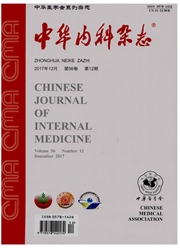

 中文摘要:
中文摘要:
目的 评价小潮气量肺保护性通气策略对非急性呼吸窘迫综合征(ARDS)患者预后的影响.方法 收集2000年1月至2015年12月非ARDS患者使用不同潮气量的中英文临床随机对照研究,按纳入与排除标准筛选文献,采用Review Manager 5.0软件对数据进行系统评价.结果 共纳入19篇临床对照研究,1 679例非ARDS机械通气患者,其中小潮气量组838例,常规潮气量组841例.小潮气量组病死率为5.87% (41/698),常规潮气量组病死率为6.52%(45/690),RR =0.90,95%CI0.62~1.31,P=0.58.与常规潮气量组比,小潮气量组不能降低病死率,但对肺部并发症,小潮气量组与常规潮气量组ARDS发生率分别为1.41% (8/569)和5.27%(29/550)(RR =0.32,95% CI0.16~0.63,P=0.001),肺炎发生率分别为7.72% (21/472)和9.67% (44/455)(RR =0.48,95% CI0.29~0.78,P=0.003),肺不张发生率分别为14.77% (79/535)和18.64% (99/531)(RR=0.78,95%CI0.391~1.356,P=0.48),提示小潮气量通气可降低非ARDS患者ARDS、肺炎发生率,但不降低肺不张发生率.结论 对非ARDS患者,小潮气量肺保护性通气策略较常规通气可降低非ARDS患者ARDS、肺炎发生率,但不能降低病死率、肺不张发生率.
 英文摘要:
英文摘要:
Objective To evaluate the effects of tidal volume on the survival in adult patients without acute respiratory distress syndrome (non-ARDS).Methods We searched relevant clinical randomized controlled trials (RCT) from January 2000 to December 2015.Meta analyses related to the effects of tidal volume on mortality in non-ARDS adults were conducted using the methods recommended by the Cochrane Collaboration.Results A total of nineteen RCTs (n =1 679) were finally included.There were 838 patients ventilated with low tidal volume,and the other 841 patients ventilated with normal tidal volume.The mortality rates were not significantly different between low tidal volume group and control group (5.87% vs 6.52%;RR =0.9,P =0.58).But respiratory complications were significantly lower in low tidal volume group,such as development of acute respiratory distress syndrome(RR =0.32,95% CI 0.16-0.63,P =0.001),pneumonia (RR =0.48,95% CI 0.29-0.78,P =0.003),while the incidence of atelectasis was quite comparable between two groups (RR =0.78,95% CI 0.391-1.356,P =0.48).Conclusion Non-ARDS patients ventilated with low tidal volume is associated with a lower risk of pulmonary complications,yet clinical outcome,mainly mortality is similar to that of patients with regular tidal volume.
 同期刊论文项目
同期刊论文项目
 同项目期刊论文
同项目期刊论文
 期刊信息
期刊信息
